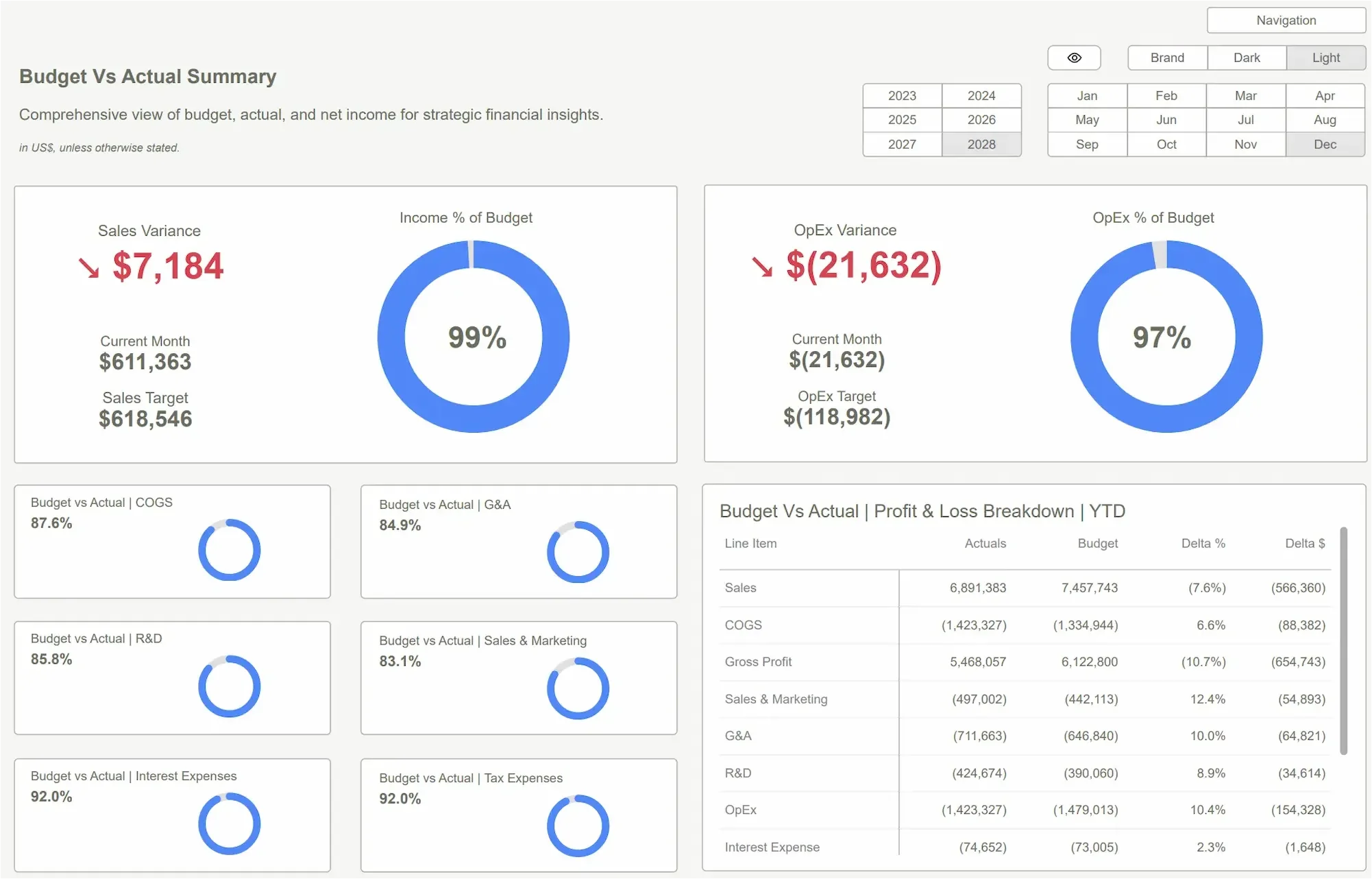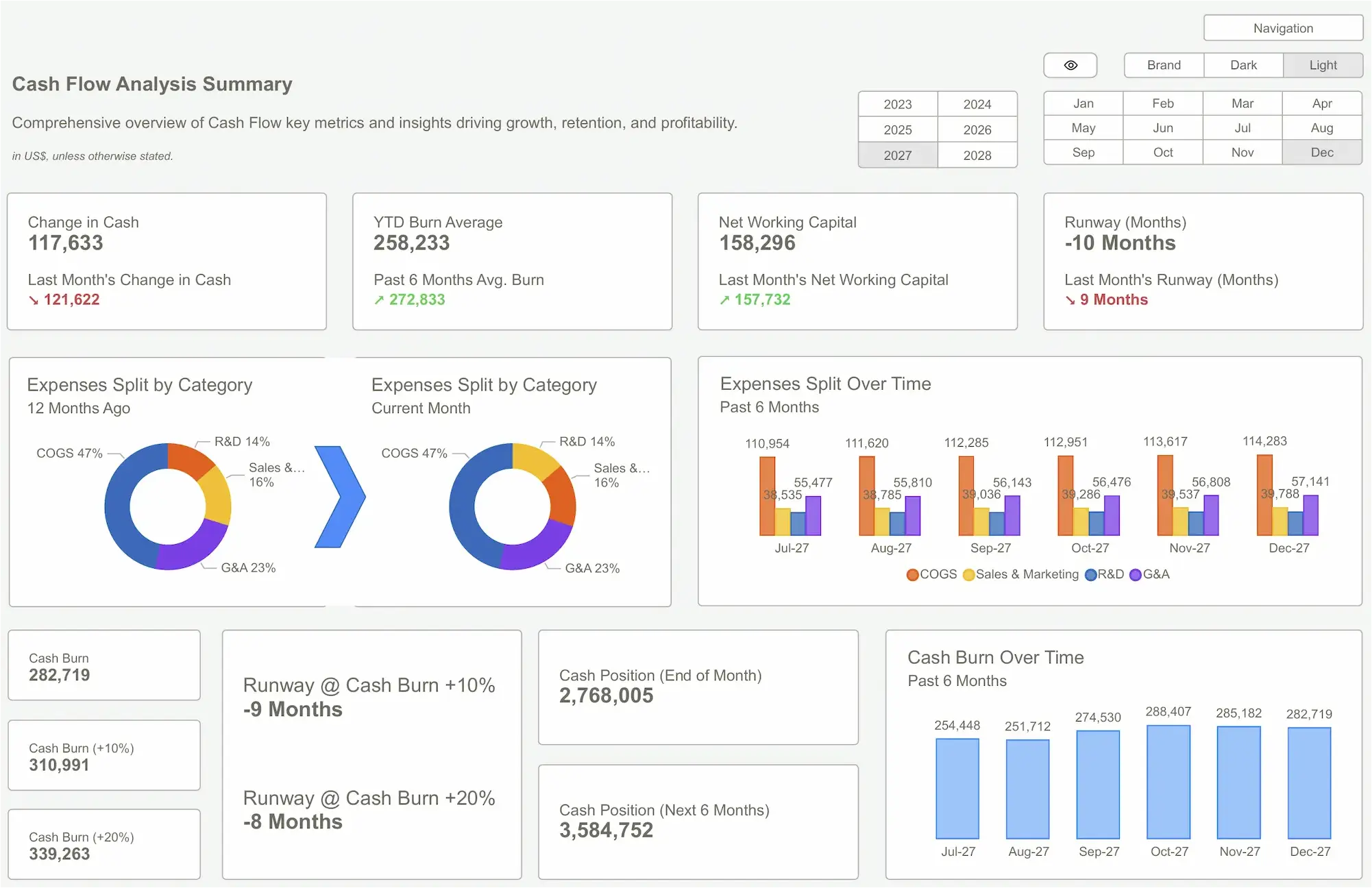FP&A: Your Burn Rate is Lying to You
Most startups are flying blind, and they don’t even know it. You have a dashboard. You have a bookkeeper. You track your burn rate religiously. You think you know your runway. But the number you’re looking at—that simple, clean burn rate figure—is almost certainly a lie.
It’s not a malicious lie, but a lie of omission. It’s the product of a dangerous oversimplification: (Cash Out - Cash In) / Time. This rearview mirror calculation feels comforting until you hit a pothole you never saw coming. The consequences are brutal: panicked fundraising rounds, sudden hiring freezes, and the dreaded "we have 30 days of cash left" conversation with your board. This isn't just about bad math; it’s about making critical strategic decisions based on flawed intelligence.
The problem isn't your spreadsheet skills; it's your model. A static burn rate ignores the dynamic, messy reality of running a business. Real FP&A (Financial Planning & Analysis) isn’t about reporting the past; it’s about accurately modeling the future. This is how you stop flying blind and start navigating with precision.
The Anatomy of a Flawed Burn Rate
So, how does a number that seems so straightforward become so deceptive? It happens when your financial oversight is treated as a reporting function instead of a strategic one.
The "rear-view mirror" approach is the primary culprit. You get last month’s bank statements, your controller cleans them up, and you get a burn number. The process is passive. But your business is not. This static view completely ignores the drivers that will define your next 3-6 months.
Here are the signs you’re relying on a flawed model:
- You get hit with "surprise" expenses. That annual D&O insurance premium or the SaaS renewal that’s 30% higher than last year wasn’t a surprise. It was just absent from your simple burn calculation.
- Your hiring plan doesn't match your cash plan. You budget for a new engineer starting next month, but you forget the 3-month recruiting lead time, the recruiter’s fee, and the new laptop. The cash for that hire goes out long before their salary does.
- Revenue forecasts ignore cash reality. Your sales team celebrates a $100k deal, but your AR report shows the client is on Net 90 terms. That’s not cash; it’s a promise. A promise doesn’t make payroll.
Most founders try to solve this with a new tool—a shinier dashboard. But a dashboard just visualizes your data. If the underlying data model is wrong, you’ve just built a prettier-looking lie. It’s garbage in, gospel out. The problem isn’t the tool; it’s the thinking.
 FP&A
FP&AFrom Static Numbers to Dynamic Realities
The critical shift required is moving from reporting to modeling. You must challenge the flawed assumption that your burn rate is a single, fixed number. It’s not. Your burn rate is a range of probable outcomes.
A proper FP&A function doesn’t just ask, "What was our burn last month?" It asks:
- "What will our burn be in three months if our two biggest clients pay 30 days late?"
- "How does our runway change if our top sales candidate accepts our offer versus the runner-up?"
- "What is the cash impact of pushing our product launch by six weeks?"
Think of it like this: A simple burn rate is your car’s speedometer. It tells you how fast you're going right now. A dynamic FP&A model is the entire GPS navigation system. It accounts for your speed, but also for traffic ahead, road closures, elevation changes, and your fuel level. It calculates your true estimated time of arrival. One is a data point; the other is a decision-making engine.
This is where different departments are forced into alignment. The sales team’s aggressive forecast gets tempered by the finance team’s collection data. The HR team’s hiring timeline gets mapped against the actual cash-out schedule. Suddenly, everyone is looking at the same map, not just their own corner of it. This is the "aha moment"—when the executive team stops arguing about whose numbers are right and starts collaborating on a unified plan based on a shared, dynamic reality.
 Forensic Accounting: You're Bleeding Cash Silently
Forensic Accounting: You're Bleeding Cash SilentlyYou’re Not Being Robbed—But You Are Bleeding Money
Getting this right isn't about esoteric financial wizardry. It’s a structured process of trading simplicity for clarity. You’re not being robbed by a single, massive event; you’re bleeding out from a thousand un-modeled paper cuts.
Here’s what building a real FP&A model looks like, simplified:
- Isolate the True Drivers: Go beyond salaries and rent. List every key variable: average sales cycle, customer payment terms, vendor payment terms, hiring lag times, payroll tax cycles, seasonality, and one-off capital expenditures.
- Build Scenarios, Not a Forecast: Create three versions of your future—a Base Case (what you expect), a Best Case (that big deal closes early), and a Worst Case (a key client churns, a hire takes twice as long). The truth is usually somewhere in between, but now you know the boundaries of your playing field.
- Stress-Test Everything: Your model should be a digital sparring partner. What happens to our runway if we lose our biggest customer? What if a supplier increases prices by 15%? A robust model answers these questions in minutes, not days.
The transformation is stark.
- Before: Anxiety before every board meeting. Reactive, gut-feel decisions. Debating for a week whether you can afford a new marketing hire.
- After: Confidently answering any question from an investor. Proactive, data-informed strategy. Knowing that making that hire shortens your runway by 2.5 weeks but gives you a 90% chance of hitting Q4 revenue goals.
This clarity directly informs your most critical strategic decisions—when to raise capital, how aggressively to scale, and whether to pivot or double down. It’s the connective tissue between your financial data, your operational reality, and your strategic ambitions.
 FP&A | Cube – Financial Reporting FP&A TopicsData Analytics Consulting
FP&A | Cube – Financial Reporting FP&A TopicsData Analytics ConsultingLet’s be blunt. Your beautifully designed dashboard is useless if it’s feeding you misinformation. Chasing a single, static burn rate is a fool’s errand. It’s a vanity metric that creates the illusion of control while obscuring the risks hiding just beneath the surface.
The goal isn't more data; it's more truth. And the truth comes from rigorous, forward-looking FP&A. Building a dynamic financial model isn't just a "nice to have" for finance nerds; it's a core function for any founder who wants to stay in business. The cost of doing nothing is continuing to gamble with your company's future, making high-stakes decisions with low-quality information.
This shift provides strategic clarity and operational visibility, empowering you to make faster, smarter decisions. You move from being a passenger, watching the numbers go by, to being the pilot, actively navigating the path ahead.
Don’t wait for the fire. Know where the smoke is coming from.
Still unsure? Send us your dashboard. We’ll spend 30 minutes telling you what critical information it’s not showing you - no strings attached.Get Started >
Ready to Unlock The Full Power of Clarity?
Explore our engagement options and pick the plan that fits your workflow.




